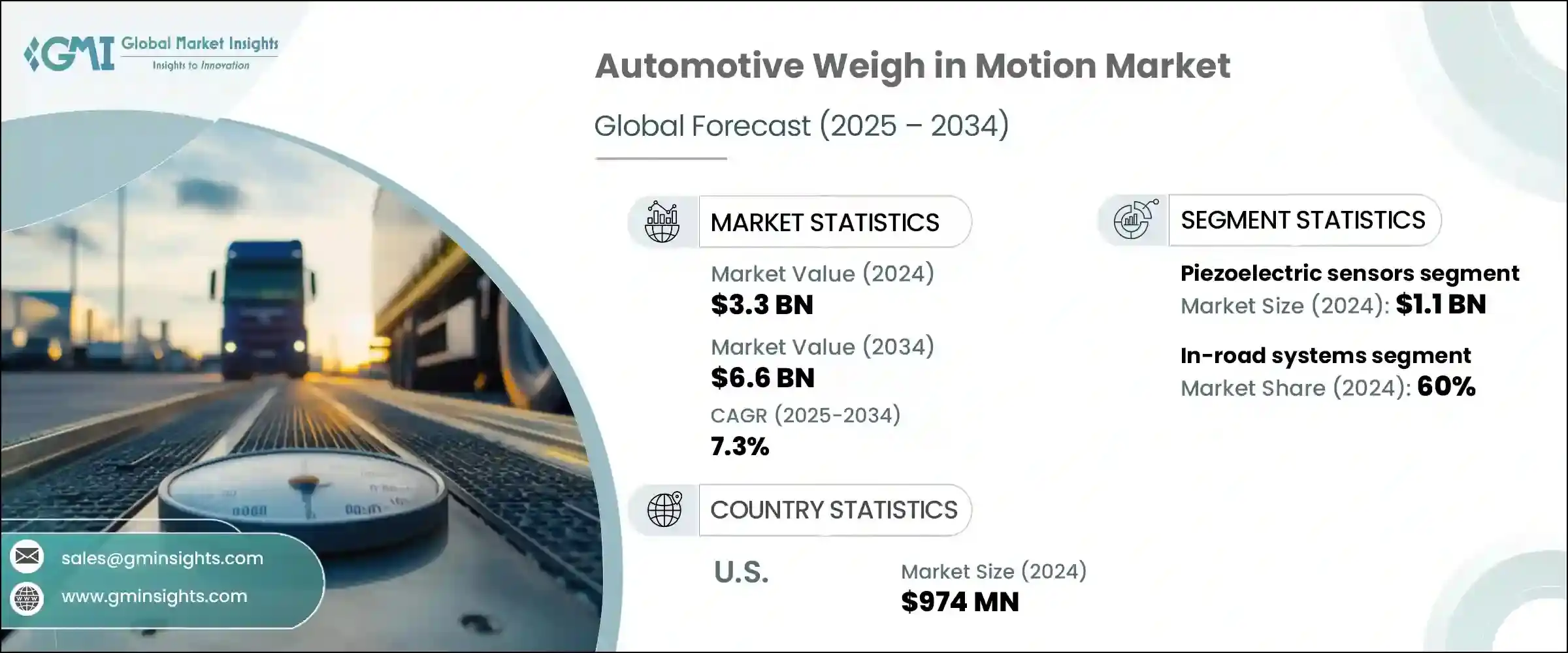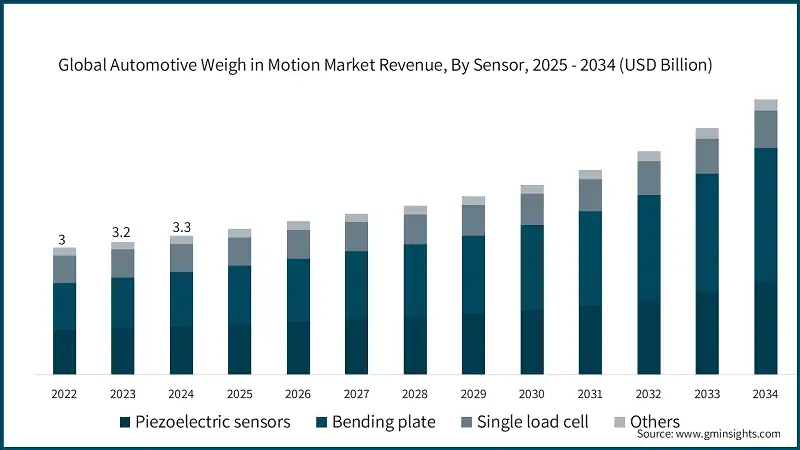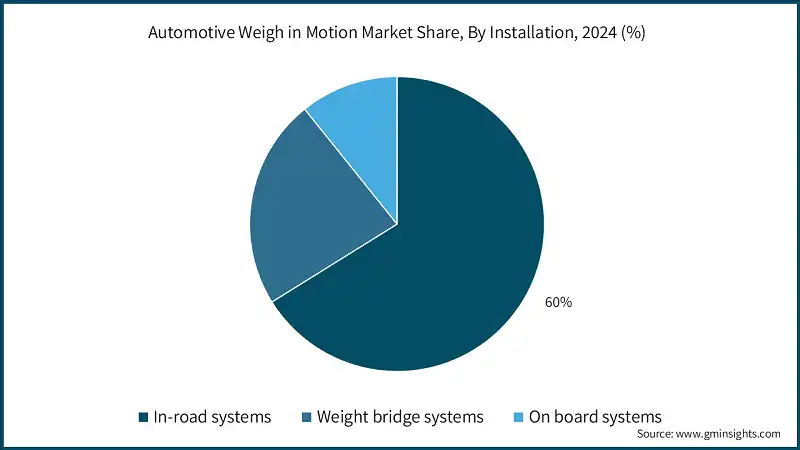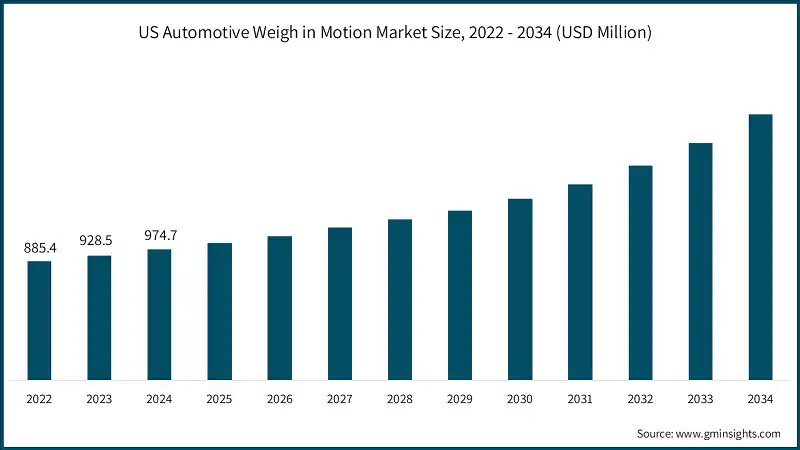Summary
Table of Content

Automotive Weigh in Motion Market
Get a free sample of this report
Thank you!
Your inquiry has been received. Our team will reach out to you with the required details via email. To ensure that you don't miss their response, kindly remember to check your spam folder as well!
Form submitted successfully!
Error submitting form. Please try again.

Request Sectional Data
Thank you!
Your inquiry has been received. Our team will reach out to you with the required details via email. To ensure that you don't miss their response, kindly remember to check your spam folder as well!
Form submitted successfully!
Error submitting form. Please try again.
Automotive Weigh in Motion Market Size
The global automotive weigh in motion market was valued at USD 3.3 billion in 2024 and is projected to grow at a CAGR of 7.3% between 2025 and 2034. The market is poised for significant growth, driven by the increasing demand for intelligent transportation systems and real-time vehicle weight monitoring across highways, logistics hubs, toll plazas, and freight corridors.

To get key market trends
Governments and transportation authorities are increasingly adopting WIM technologies to enhance road safety, optimize infrastructure maintenance, and enforce axle-load regulations more efficiently. The integration of sensor technologies, artificial intelligence (AI), and advanced analytics is transforming vehicle weight monitoring, enabling accurate, dynamic measurement without disrupting traffic flow.
Automotive Weigh in Motion Market Report Attributes
| Key Takeaway | Details |
|---|---|
| Market Size & Growth | |
| Base Year | 2024 |
| Market Size in 2024 | USD 3.3 billion |
| Forecast Period 2025 - 2034 CAGR | 7.3% |
| Market Size in 2034 | USD 6.6 billion |
| Key Market Trends | |
| Growth Drivers |
|
| Pitfalls & Challenges |
|
What are the growth opportunities in this market?
Automotive WIM systems serve as a foundation for modern traffic management by offering features such as high-speed weight detection, automatic vehicle classification, and real-time data transmission to centralized monitoring systems. These systems are equipped with advanced sensors, embedded cameras, and cloud-based platforms to ensure high accuracy, minimize maintenance, and support interoperability with intelligent transportation infrastructure. Enhanced durability, tamper-resistance, and cybersecurity protocols are built in to safeguard critical transportation data and ensure compliance with national and international regulatory standards.
For instance, in January 2024, AxleSense Technologies introduced a next-generation AI-powered WIM solution capable of detecting overloaded vehicles with 98% accuracy at speeds exceeding 100 km/h. This innovation allows highway authorities to reduce road damage, improve toll efficiency, and strengthen law enforcement efforts while reducing congestion and manual intervention.
Technological advancements in the automotive WIM sector, including IoT-enabled sensors for predictive maintenance, machine learning algorithms for anomaly detection, and integration with digital twin platforms for infrastructure planning, are further propelling market expansion. These innovations empower authorities and logistics operators to streamline freight operations, reduce operational costs, and enhance safety and sustainability in the global transportation ecosystem.
Automotive Weigh in Motion Market Trends
- Transportation authorities and logistics operators are increasingly deploying weigh-in-motion (WIM) systems to optimize freight operations, enforce axle-load regulations, and protect road infrastructure. These solutions provide non-intrusive, real-time vehicle weight data, enabling centralized monitoring and efficient traffic flow across highways and toll systems.
- The integration of artificial intelligence (AI) and machine learning is transforming the capabilities of WIM systems by enhancing vehicle classification accuracy, overload detection, and predictive analytics. Intelligent algorithms facilitate proactive maintenance planning, real-time decision-making, and dynamic traffic management based on vehicle weight patterns.
- The shift toward smart mobility and connected infrastructure is fueling demand for automated, high-speed WIM systems that support digital transportation ecosystems. These platforms enable seamless vehicle monitoring, automated violation enforcement, and integration with fleet management systems, contributing to safer and more efficient roadway networks.
- WIM solutions are increasingly embedded within intelligent transportation systems (ITS) to support regulatory compliance with evolving global standards such as the EU Directives on vehicle weights and U.S. DOT requirements. Features like automated alerts, digital evidence generation, and real-time data sharing improve transparency and legal enforcement capabilities.
- Modular, sensor-based WIM platforms with API-driven architecture enabling interoperability, scalability, and customization across different deployment environments. This flexibility allows integration with tolling, logistics, and smart road technologies, making WIM a core component of future-ready transport infrastructure
Automotive Weigh in Motion Market Analysis

Learn more about the key segments shaping this market
Based on sensors, the market is divided into piezoelectric sensors, bending plate, single load cell and others. The piezoelectric sensors segment dominated the market, generating revenue of around USD 1.1 billion in 2024.
- The dominance of piezoelectric sensors in the weigh-in-motion (WIM) market is driven by their high durability, cost-efficiency, and ability to provide accurate measurements at high vehicle speeds. These sensors are widely adopted in highway monitoring systems due to their ease of installation and minimal maintenance requirements, making them ideal for large-scale deployments.
- For instance, in January 2024, RoadSense Technologies deployed a nationwide WIM network in Germany using advanced piezoelectric sensor arrays. This system enabled real-time vehicle load monitoring across major freight corridors, contributing to reduced road wear and improved enforcement of weight regulations.
- Piezoelectric sensor-based WIM systems offer scalable and flexible solutions for diverse roadway conditions. Their compact design and high signal sensitivity allow for seamless integration into existing infrastructure, providing reliable data for traffic management, toll collection, and infrastructure planning initiatives.

Learn more about the key segments shaping this market
Based on the installation, the automotive weigh in motion market is divided into in-road systems, weight bridge systems and on-board systems. The in-road systems segment dominated the market accounting segment and held a market share of 60% in 2024.
- The dominance of in-road systems in the weigh-in-motion (WIM) market is attributed to their ability to deliver real-time, high-accuracy vehicle weight data without interrupting traffic flow. These systems are embedded directly into the road surface, making them ideal for highway enforcement, tolling stations, and freight corridors with high vehicle throughput.
- For instance, in March 2024, the Ministry of Transport in the Netherlands implemented a nationwide in-road WIM network to monitor and enforce axle weight regulations across major highways. This deployment significantly improved compliance rates and reduced infrastructure damage caused by overloaded vehicles.
- In-road WIM systems are preferred for their discreet design, automated operation, and seamless integration with intelligent transportation systems (ITS). They support high-speed, dynamic weighing and are effective for continuous traffic monitoring, enabling authorities to maintain road safety and operational efficiency across large-scale transportation networks.
Based on axle configuration, the automotive weigh in motion market is divided into Single Axle, Tandem Axle, Triple Axle and Quad Axle. The single axle segment dominated the market in 2024.
- The dominance of the single axle segment in the weigh-in-motion (WIM) market is driven by its widespread application across commercial vehicles and ease of integration with existing WIM infrastructure. Single axle configurations are common in light- to medium-duty vehicles, making this segment a key focus area for transportation authorities and logistics operators aiming to monitor weight compliance efficiently.
- For instance, in February 2024, TransLogix Solutions implemented a nationwide WIM program in Canada focused on single axle detection to enhance load regulation among local and regional delivery fleets. This initiative improved enforcement accuracy and helped reduce road surface degradation caused by unregulated axle loads.
- Single axle WIM systems are valued for their cost-effectiveness, simplicity in calibration, and adaptability across various road types. Their high detection accuracy and rapid data processing make them ideal for both permanent installations on highways and temporary setups at logistics hubs or weigh stations.
Based on applications, the automotive weigh in motion market is divided into weight enforcement, traffic data collection, weight-based tolling, bridge protection and industrial truck weighing. The weight enforcement segment dominated the market in 2024.
- The dominance of the weight enforcement segment in the weigh-in-motion (WIM) market is primarily driven by the growing need to prevent road damage, enhance transportation safety, and ensure regulatory compliance. Governments and transportation agencies are prioritizing WIM systems to detect and penalize overloaded vehicles in real time without disrupting traffic flow.
- For instance, in January 2024, the U.S. Department of Transportation expanded its WIM-based enforcement program across several interstate highways. The initiative enabled automated detection and ticketing of overweight vehicles, significantly improving compliance and reducing manual inspection costs.
- Weight enforcement applications rely heavily on accurate, high-speed WIM technologies to monitor axle loads and gross vehicle weight. These systems enable non-intrusive, continuous monitoring and help authorities reduce road maintenance expenses, minimize accident risks, and ensure fair usage of transportation infrastructure.
Based on the end use, the automotive weigh in motion market is divided into government, transportation, private sector and others. The government segment dominated the market in 2024.
- The dominance of the government segment in the weigh-in-motion (WIM) market is driven by the need to enhance road safety, enforce weight regulations, and protect transportation infrastructure. Public sector authorities rely on WIM systems for continuous vehicle weight monitoring to ensure compliance with legal axle load limits and reduce damage to road networks.
- Government entities typically lead large-scale deployments of WIM systems across national highways, border checkpoints, and toll plazas. These systems enable efficient traffic management, support regulatory enforcement, and help minimize manual inspections through automated data collection and processing.
- Integration of WIM systems into broader intelligent transportation and regulatory frameworks allows governments to centralize data, improve operational transparency, and make informed decisions for infrastructure planning and maintenance. The scalability and reliability of these solutions make them essential tools in modern public sector transportation strategies.

Looking for region specific data?
US dominated the North America automotive weigh in motion market with a revenue of USD 974 million in 2024 and is expected to grow with a CAGR of around 7.6% during the forecast period.
- The U.S. dominated the North America automotive weigh-in-motion (WIM) market due to substantial government investments in infrastructure modernization and regulatory enforcement. The country’s extensive highway network and focus on ensuring compliance with axle load regulations have accelerated the adoption of advanced WIM systems.
- Strong emphasis on road safety and freight management drives the deployment of high-accuracy WIM technologies across federal and state transportation agencies. These initiatives support reduced road damage, improved traffic flow, and enhanced data collection for policy planning.
- The U.S. market benefits from well-established intelligent transportation systems (ITS) integration and robust funding mechanisms, enabling scalable and efficient WIM deployments across diverse transportation corridors.
Predictions suggest that from 2025-2034, the Germany automotive weigh in motion market will grow tremendously.
- Predictions suggest that from 2025 to 2034, the Germany automotive weigh-in-motion (WIM) market will grow tremendously, driven by increased government focus on infrastructure protection and advanced traffic management. Investments in modernizing road networks and implementing smart transportation systems are expected to fuel this growth.
- For instance, in early 2025, the German Federal Ministry of Transport announced plans to expand its nationwide WIM deployment to improve overload enforcement and reduce road maintenance costs. This initiative includes integrating AI-powered sensors and real-time data analytics to enhance monitoring accuracy.
- Collaborations between technology providers and logistics companies are enabling the development of next-generation WIM solutions, supporting sustainable freight operations and compliance with evolving European regulations. Such advancements will further accelerate market expansion over the forecast period.
Predictions suggest that from 2025-2034, the China automotive weigh in motion market will grow tremendously.
- China automotive weigh-in-motion (WIM) market will grow tremendously, driven by rapid infrastructure development and stringent enforcement of vehicle weight regulations. The country's focus on modernizing road networks and enhancing transportation safety is expected to significantly increase demand for WIM systems.
- Technological advancements such as AI-enabled sensors and cloud-based analytics will enhance real-time monitoring, predictive maintenance, and data-driven decision-making capabilities in WIM solutions. These innovations support the growing need for efficient freight management and infrastructure protection.
- China’s strategic initiatives to develop smart cities and intelligent transportation systems (ITS) across urban and rural areas will further accelerate the adoption of WIM technologies. The integration of WIM systems into broader transportation frameworks will improve traffic flow, regulatory compliance, and operational efficiency.
Predictions suggest that from 2025-2034, the UAE automotive weigh in motion market will grow tremendously.
- UAE automotive weigh-in-motion (WIM) market will grow tremendously, driven by increasing investments in smart infrastructure and regulatory measures to enforce vehicle weight limits. The country’s focus on modernizing its transportation network and enhancing road safety will significantly boost the adoption of WIM systems.
- The integration of advanced technologies such as AI-enabled sensors and real-time data analytics is expected to enhance monitoring accuracy and operational efficiency in WIM applications. These innovations will support efficient freight management and infrastructure preservation.
- Strategic initiatives aimed at developing intelligent transportation systems (ITS) and smart city projects across the UAE will further accelerate WIM system deployments. This will improve traffic management and regulatory compliance in both urban and highway settings.
- Growing commercial logistics activities and regional trade expansion will increase demand for scalable and interoperable WIM solutions to support sustainable transportation and regulatory enforcement.
Automotive Weigh in Motion Market Share
- The top 7 companies, Kapsch TrafficCom AG, Q-Free ASA, International Road Dynamics Inc. (IRD), SWARCO AG, Intercomp Company, TE Connectivity, and Kistler Group hold a significant market share of over 30% in the self-storage software market in 2024.
- Kapsch TrafficCom AG remains a market leader by offering advanced WIM solutions integrating AI-powered analytics, cloud-based monitoring, and high-precision sensor technology. Kapsch’s systems enhance traffic enforcement and infrastructure protection globally.
- For instance, in February 2024, Kapsch TrafficCom AG launched an AI-enabled WIM platform with cloud integration that improved overload detection and real-time traffic data analytics across European highways.
- Q-Free ASA continues to lead with its innovative smart transportation solutions, combining machine learning algorithms and sensor technologies for predictive maintenance and accurate vehicle weighing.
- For instance, in January 2024, Q-Free deployed machine learning-powered WIM systems to reduce road damage and improve freight management in Nordic countries.
- International Road Dynamics Inc. (IRD) leverages cutting-edge vehicle classification and automated enforcement technologies to deliver scalable WIM solutions across major freight corridors.
- For instance, in June 2024, IRD rolled out advanced WIM systems featuring real-time vehicle classification and automated enforcement capabilities in North America.
- SWARCO AG leads with integrated intelligent transportation systems that incorporate WIM technology for dynamic traffic management and regulatory compliance, particularly in urban environments.
- For instance, in March 2024, SWARCO enhanced its ITS offerings by deploying WIM solutions across German urban networks to optimize traffic flow and enforcement.
- Intercomp Company specializes in portable and fixed WIM devices designed for rapid deployment and precise weight measurement, supporting logistics and industrial vehicle applications worldwide.
- For instance, in April 2024, Intercomp launched new WIM products that offer high-precision vehicle weighing and ease of installation for diverse operational needs.
- TE Connectivity develops durable sensor-based WIM modules featuring robust connectivity and seamless integration capabilities for smart infrastructure projects.
- For instance, in May 2024, TE Connectivity introduced advanced sensor modules for WIM systems used in smart road infrastructure across the Middle East.
Automotive Weigh in Motion Market Companies
Major players operating in the automotive weigh in motion industry are:
- Econolite
- Intercomp
- International Road Dynamics
- Kapsch TrafficCom
- Kistler
- Q-Free ASA
- Siemens Mobility
- SWARCO AG
- TDC Systems Ltd.
- TE Connectivity
Leading companies in the automotive weigh-in-motion (WIM) market are adopting strategic initiatives such as mergers and acquisitions, strategic partnerships, and increased investments in sensor innovation, artificial intelligence (AI), and real-time analytics. These players are focused on integrating next-generation sensor technologies, cloud-enabled platforms, and automated enforcement tools to enhance accuracy, efficiency, and scalability of WIM systems. Such advancements strengthen their market positions by enabling real-time vehicle monitoring, improving traffic law enforcement, and supporting infrastructure preservation across applications such as freight management, toll collection, and bridge protection.
Organizations are also investing in modular WIM solutions, hybrid infrastructure models, and edge computing capabilities. These technologies help facilitate faster data acquisition, enable seamless integration with traffic and transportation systems, and ensure high availability and responsiveness of WIM systems under dynamic road conditions. Collaborations with smart city solution providers, transportation agencies, and infrastructure developers are further accelerating the creation of comprehensive, interoperable WIM ecosystems on a global scale.
Automotive Weigh in Motion Industry News
- In April 2024, Kapsch TrafficCom AG launched an upgraded WIM solution integrated with AI-powered vehicle classification and cloud-based analytics, enabling transportation agencies to improve overload detection, road safety, and traffic enforcement in real time.
- In March 2024, Q-Free ASA introduced a modular WIM platform with machine learning capabilities for predictive maintenance and real-time road condition monitoring, aimed at reducing infrastructure wear and optimizing freight logistics.
- In February 2024, International Road Dynamics Inc. (IRD) deployed an advanced WIM system featuring automated vehicle recognition and enforcement functionality, designed to support tolling efficiency and reduce operational costs across major North American highways.
- In January 2024, SWARCO AG announced the integration of its WIM systems with smart city infrastructure, enabling synchronized traffic control, automated weight enforcement, and improved urban mobility management in European metropolitan areas.
- In December 2023, Intercomp Company unveiled a new generation of portable WIM devices designed for rapid deployment and high-accuracy weight measurement, catering to temporary checkpoints and remote transport hubs.
- In November 2023, TE Connectivity released a robust line of sensor modules for embedded WIM systems, offering enhanced durability, precision, and connectivity for extreme roadway environments and high-volume vehicle flow.
- In November 2023, Kistler Group launched an innovative piezoelectric sensor system optimized for WIM applications, enabling precise axle load measurement and supporting bridge protection and heavy vehicle compliance programs across global markets.
The automotive weigh in motion market research report includes in-depth coverage of the industry with estimates & forecasts in terms of revenue ($ Million) from 2021 to 2034, for the following segments:
Market, By Installation
- In-road systems
- Weight bridge systems
- Onboard systems
Market, By Sensor
- Piezoelectric sensors
- Bending plate
- Single load cell
- Others
Market, By Axle Configuration
- Single Axle
- Tandem Axle
- Triple Axle
- Quad Axle
Market, By Application
- Weight enforcement
- Traffic data collection
- Weight based tolling
- Bridge protection
- Industrial truck weighing
Market, By End Use
- Government
- Transportation
- Private Sector
- Others
The above information is provided for the following regions and countries:
- North America
- U.S.
- Canada
- Europe
- Germany
- France
- UK
- Spain
- Italy
- Russia
- Nordics
- Asia Pacific
- China
- Japan
- India
- South Korea
- ANZ
- Southeast Asia
- Latin America
- Brazil
- Mexico
- Argentina
- MEA
- UAE
- Saudi Arabia
- South Africa
Frequently Asked Question(FAQ) :
Who are some of the prominent players in the automotive weigh-in-motion industry?
Key players in the sector include Econolite, Intercomp, International Road Dynamics, Kapsch TrafficCom, and Kistler.
Why is the piezoelectric sensors segment dominating the market?
The piezoelectric sensors segment generated revenue of approximately USD 1.1 billion in 2024, leading the market due to its widespread adoption.
How much is the North America automotive weigh-in-motion industry worth?
The North America automotive weigh-in-motion market, led by the U.S., recorded USD 974 million in 2024 and is expected to grow at a CAGR of around 7.6% during the forecast period.
How big is the automotive weigh-in-motion market?
The global automotive weigh-in-motion industry was valued at USD 3.3 billion in 2024 and is projected to grow at a CAGR of 7.3% from 2025 to 2034.


